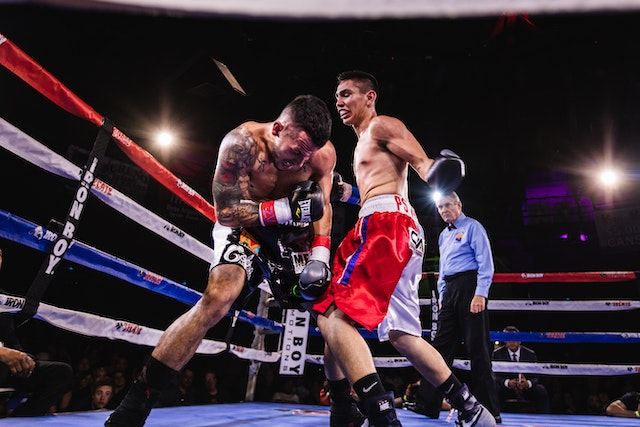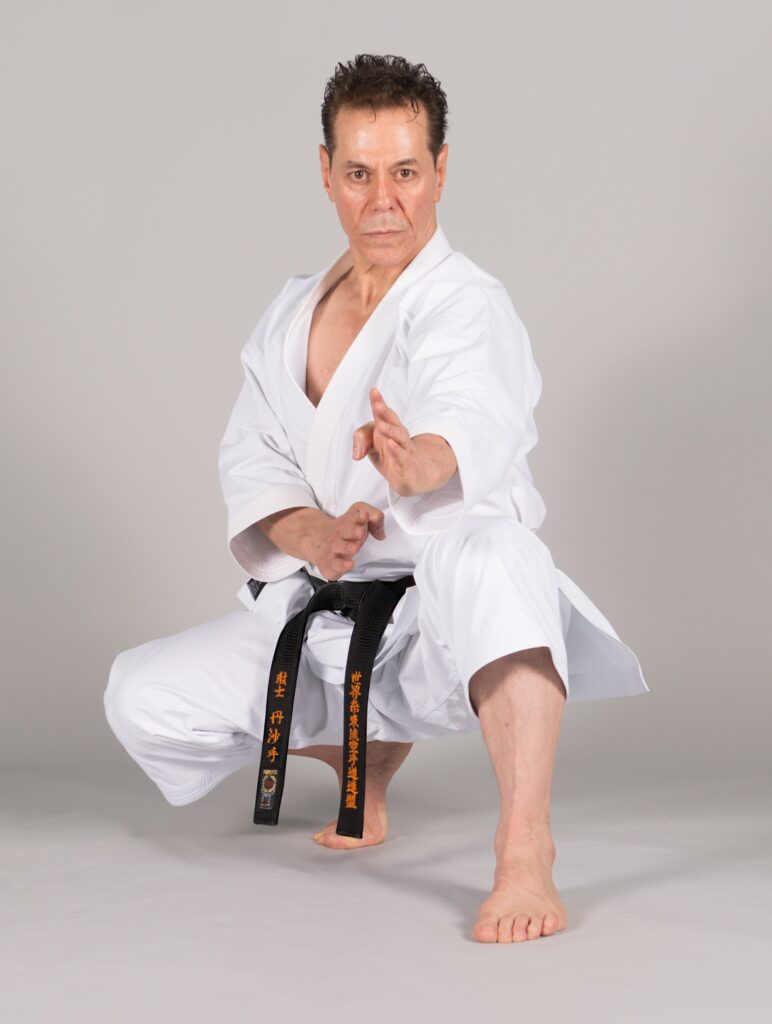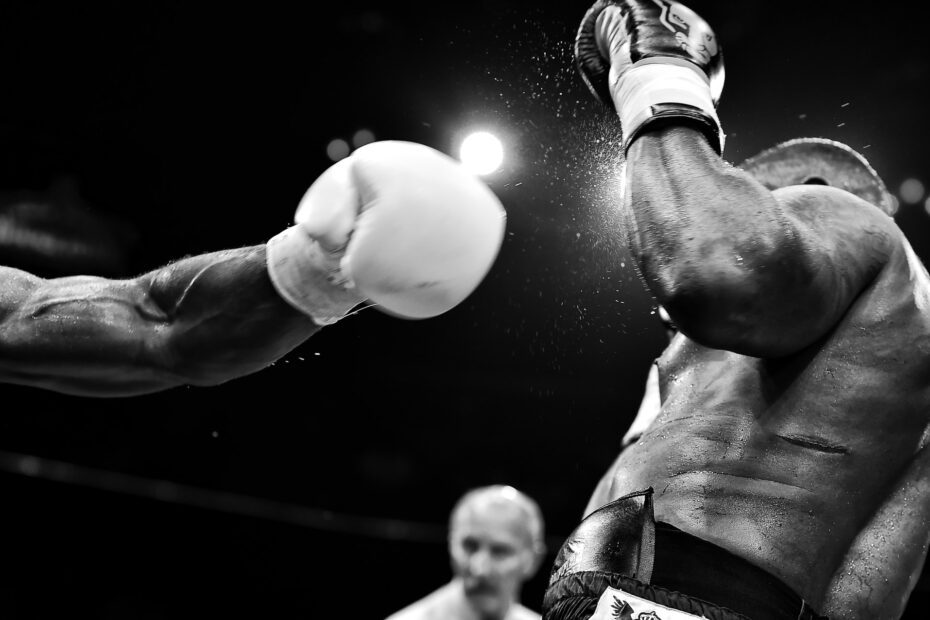Boxing and karate are two of the most glorified combat sports in pop culture! From the Rocky/Creed movies to the Karate Kid saga, many people have at least heard of boxing and karate. The purpose of this blog post is to become familiar with the basic history of boxing and karate then cover the key differences between the two martial arts.
The history of boxing

Today’s Western-style of boxing is a stand-up striking art focused on throwing punches, head movement, and footwork. Boxing’s roots go deeper than the ancient Greek Olympics in 688 BC. There’s evidence of boxing appearing in old carvings by the Sumerians that go even further back in time. Over the years, it’s evolved into a competitive sport with a skillset that can also be used in self-defense and serve as a solid foundation for combat sports like mixed martial arts (MMA).
Famous boxers that have transcended the sport in more ways than one are:
- Muhammad Ali
- Laila Ali
- Oscar de la Hoya
- Claressa Shields
- Mike Tyson
- Manny Pacquiao
- Holly Holm
Each of these boxers has found success outside of the ring in different ways whether it be business, politics, or philanthropy. Boxing has a way of connecting with the general public by appealing to both boxing purists and people who support athletics. Now that you’re a little more familiar with boxing, let’s cover the history of karate and its roots.
The history of karate

Karateka (practitioners of karate) can trace their roots back to the Ryuku Kingdom in Okinawa. Karate is heavily influenced by Chinese martial arts. Older karate styles and some modern karate styles teach grappling techniques like throws and joint locks along with punches, kicks, elbow strikes, knees, and other striking techniques. Karate made its way to Japan after Japan annexed Okinawa in 1879. This martial art began to spread quickly in Japan as karate clubs started to form in the early 1920s and 1930s. Now an Olympic sport, karate continues to be popular around the world thanks to the spread of karate schools and the inclusion of karate in pop culture (i.e. Karate Kid).
Below is a list of famous karateka who have achieved global success:
- Roberta Dominici
- Yoshizo Machida
- Chuck Norris
- Joe Lewis
- Bill Wallace
- Gabriela Navarrete
- Sakura Kokumai
- Lyoto Machida
Have you heard of any of the individuals listed above? Some of the karateka listed above are current practitioners while others are retired and pursuing other interests like Chuck Norris. Other karate fighters have had success in other combat sports such as Lyoto Machida competing in MMA.
Key differences between boxing and karate
There are several key differences between karate and boxing that go beyond their names and origins. These differences affect how fighters score and train for competition. As you read on, we will cover equipment used in boxing and karate. We will even go into detail regarding the categories of gloves one might encounter when it comes to boxing gloves.
What type of equipment is used in boxing?
All boxers will use boxing gloves, a mouth guard, groin protectors, and boxing shoes. Professional boxers will often use headgear for training but not in organized matches whereas amateur fighters use headgear for both amateur bouts and sparring. Immediately below, we cover the 4 main types of boxing gloves you may or may not be aware of.
4 main types of boxing gloves
Boxers will often have preferences for glove styles and glove brands since there are different types of boxing gloves available in the market. These main categories are:
- Training gloves: Training gloves tend to be all-around gloves that can be used in different ways. These uses include partner drills in class, mitt/pad work, heavy bag sessions.
- Bag gloves: Bag gloves are designed with heavy bag work in mind. Since they’re optimized for speed and help improve technique, heavy bag gloves have less padding. This helps boxers feel the impact and power of their punches. The feedback they receive helps them adjust their technique accordingly.
- Sparring gloves: Since the goal of these gloves is to improve sparring sessions, sparring gloves have more padding. The increase in padding helps absorb the impact. Sparring gloves need to be 16oz and higher to be used in sparring in many gyms.
- Competition gloves: Depending on the sanctioning body and weight class, boxing gloves used in competition tend to be lighter. Weighing around 6-10oz, competition gloves have less padding. This results in more significant damage in boxing matches.
Hobbyists will most likely opt for lower to mid-tier quality gloves. On the other hand, amateur boxers and professional boxers tend to have their preferred brands and glove styles. Highly experienced boxers will be opinionated in their glove choices due to factors like glove fit, padding distribution, and even glove stitching.
What type of equipment is used in karate?
Traditional karate utilizes the gi which is a uniform that has different variations in martial arts such as Brazilian Jiu Jitsu, Tae Kwon Do, and judo. Competition rulesets in karate will often call for gloves, headgear, footgear, and mouth guards when point-fighting is involved.
For full-contact karate like Karate Combat, fighters will wear pants, belts, gloves, and mouth guards. Competitors will most likely wear cups or some type of groin protection as well. The design of groin protection used in karate won’t be as bulky as boxing groin protectors since they can’t inhibit a fighter’s ability to throw kicks.
Is kicking allowed in boxing?
Kicks are not allowed in boxing unless it is a form of kickboxing like Muay Thai and Dutch kickboxing. Ground fighting (i.e. armbars, triangles, mounted armbars etc.) is not allowed in boxing as well. All of the action in boxing happens on the feet and in the ring.
Go train!
Hopefully, we were able to answer your questions about the differences between boxing and karate! If you have any other questions we can answer for you, let us know in the comments below and we’ll quickly get back to you.
In the meantime, go train and level up!

Top ,.. top top … post! Keep the good work on !
The articles you write help me a lot and I like the topic